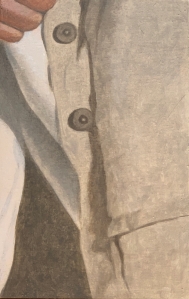Painting backwards, again
July 6, 2020
I just finished creating a series of panels using the mixed technique. It’s an indirect method of painting that works best when you already have a clear design in mind: you know where the lights and the darks will be; and you have a pretty good idea about your placement of chromatic masses. Depicting something realistic, or surrealistic, then is usually its best application.
Speaking very, very generally, because realism or representational art (in terms of subject matter) has been out of fashion for a century or so, so has interest in the techniques best suited to it. That is, an indirect technique has not been valued as highly as an alla prima one. Artistic expression then has been seen (again for the most part) as the process of allowing the artist’s unconscious mind to freely roam, expressing itself spontaneously through lines, shapes and colours – with as little conscious-mind interference as possible. Certainly, it may bounce off externals of self and other, but abstraction is the aim. The artist then functions as a midwife, through which process one hopes to create something universal and beautiful. If not beautiful, then at least shocking in an insightful way. That’s modern/contemporary art.
But because of the valuation for this alla prima, zen-like spontaniety, the mixed technique as an indirect method of painting has been out of vogue. In a world of deconstructed subject matter, artistic expression too has become deracinated. Techniques developed over centuries for building up layers of beauty have either been largely forgotten, thrown onto the trash heap, or preserved by conservators and reactionary geeks like myself. In that sense, it’s been difficult for me to learn about them, though internet forums these days have been very helpful. All in all, I have had more failures than successes as I’ve gone back to the drawing board again and again, reinventing the wheel. One success though, has been what I call “painting backwards”. It’s a process whereby the underlying layers of substrate or underpainting are used to reclaim the highlights and quarter tones – instead of slapping white pigment back in on top.

Final layer of paint on the Vaardijk. Note the highlights of the green tree in the foreground, right and the building roofs on the right side of the canal. They are highlights reclaimed through painting backwards and/or light glazes.The highlights of the white building foreground, left, are a more impasto lead white.
So to return to my recent experiments in indirect painting. The subject matter of the panel on the left was based on a (realistic) black and white study of my own, while the panel on the right, below, was based on cut up pieces of a photograph for the A Piece of Me project. In both cases, because I already knew where I was going, I could develop the image: first in black and white (using india ink); then through a chromatic underpainting (in egg tempera). These under layers served as guides for later levels but they also assisted in reclaiming the highlights during the painting process.

This is one of the more delicious panels created through the mixed technique. The luminosity of the linen jacket was a pure delight to discover. This was possible by rediscovering the forms I had already supplied as suggestions. The oil level created mass.
I consistently asked myself: What is the difference between a white or yellowish highlight created with a full-on coarse impasto applied alla prima and a highlight rediscovered through layers of nuanced translucence? Huge! Both have their roles to play in the grand scheme of things although I frankly admit my passion for the latter. The A Piece of Me mixed media project mentioned above then is envisioned not only as a mixture of different media but also a mixture of approach, that is, some will be executed all prima and others indirect. The proof, I expect, will be in the visual pudding.
